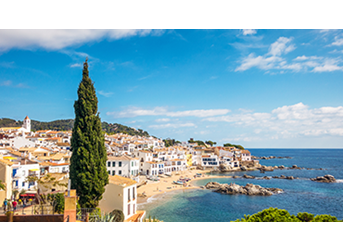How to move to Spain
Get the best value for money when you move



Guide on moving to Spain
9 minute readFor understandable reasons, Spain has long been a hugely popular destination for expats from all over the world. As of 2021, more than 300,000 British nationals reside in Spain; these expats are part of a broader community of over six million foreign residents who choose to live out their lives in Spain. The hot weather and laidback lifestyle for which Spain is renowned have proved to be a huge draw for Brits looking to move abroad.
Whether you wish to retire abroad or moving to Spain for professional reasons, there are a few things that you’ll need to bear in mind before you emigrate.
Do you need a visa to move to Spain?
Those looking to live in Spain for longer than three months require a national visa, or visado nacional, unless they are citizens of the EU/EEA or Switzerland. Now that the UK is outside of the European Union, British citizens who wish to stay for longer than three months in, or emigrate to, Spain are required to apply for a national visa.
Expats from the UK, USA, Canada and Australia will also need to apply for a residence and work permit, or visado de trabajo y residencia, in order to live and work in Spain.
How to get your NIE
As a foreign national emigrating to Spain, you’ll need to apply for your NIE (ID number for foreigners, or Número de Identificación de Extranjero). Much like a National Insurance number in the UK, an NIE enables expats to buy property in Spain, rent accommodation, enter employment and pay taxes.
The process that you need to follow here will vary depending on your nationality. If you are from the EU, you have the choice of either applying for your NIE at the Spanish Consulate in your country or at your local police station upon arriving in Spain. Alternatively, you can hire a legal representative in Spain to make an application on your behalf before you arrive.
If you would rather register as a resident in person, you will need to make an appointment at your local immigration office or at the police station within your province. Once you have registered, you will receive a residence certificate that displays your name, address, nationality, NIE number and the date of registration.
How to register on the padrón
Those planning on living in Spain for more than three months are also required to register with your local town hall census, or padrón. You will need to do this at your local town hall and will require a form of official identification. This can take the form of one of the following:
- A passport
- Your NIE or residence certificate
- The deed to your house or copy of your rental contract
- A recent utility bill in your name
A small fee is incurred by some town halls for registering you and providing you with your certificate (certificado de empadronamiento). This is a nominal fee, however, and you will be able to enjoy the following benefits once you have registered:
- Access to public services and discounts
- Access to income-related benefits and social care
- A tax reduction
- The ability to register for local healthcare
- The ability to enrol children in school
- Voting rights in local elections
- The ability to register a car with a Spanish number plate
Opening a bank account in Spain as a foreigner
It is worth noting that you will not be able to open a bank account in Spain as a non-Spanish resident without an NIE.
Multinational banks such as BBVA and Banco Santander have proven popular in the past with foreigners looking to open a bank account in Spain. There is a wide range of resident bank accounts that expats can choose from. Non-resident bank accounts are often better suited to those who own a Spanish holiday home but would prefer to be resident for less than half, i.e. fewer than 183 days, of the year.
Read our full guide on how to open a bank account in Spain.
What is the currency in Spain?
The euro is the official currency that has been in use in Spain since 2002. It replaced the peseta, which had been Spain’s currency for more than a hundred years. The euro is the world’s second most traded currency, and it is used by 19 countries within the Eurozone. Note denominations include 5, 10, 20, 50, 100, in addition to the rarer 200 and 500 notes. Each euro is made up of 100 cents.
If you are moving to Spain from UK, you can monitor the pound to euro rate, and you’ll also be able to set up a rate alert from your online account. This will mean that we’ll keep you informed via email or SMS message if the rate reaches your desired level before you make your exchange.
Moving to Spain with pets
If you’re moving to Spain and plan on bringing your pet with you, there are some regulations that you must adhere to.
Moving to Spain with pets requires you to carry a valid European Pet Passport for travel. Once your pet has been micro-chipped and a blood test has been taken, you can receive a Pet Password from a licensed vet. An EU Pet Passport features an ID number and records of previous vaccinations, in addition to other relevant information.
Your pet will need to have received both an ISO 11784/11785 compliant microchip implant and the rabies vaccination, in line with the Spanish government’s requirements. These vaccinations must have taken place before your pet was fitted with a microchip, and they need to have been administered at least 21 days before you enter Spain and not more than a year prior to entry.
Most pet microchips are ISO compliant. If your pet’s microchip is not compliant, however, you will need to bring the appropriate scanner with you.
Dogs and cats that are under 15 weeks of age and thus unvaccinated with a valid rabies vaccine are not authorised to enter Spain.
Foreign currency exchange for moving to Spain
Moving abroad always involves large money transfers between your existing bank account and your new account abroad. Whether you’d like to pay for a Spanish property by the coast or need to transfer your savings over to your new Spanish bank account, you’ll need to make several overseas payments when moving to Spain from the UK.
As foreign exchange specialists, we’re committed to offering our customers a competitive exchange rate and low transfer fees. With some banks charging as much as £30 in transaction fees per payment, you can save both time and money when you choose to send money to Spain with Moneycorp.
How do I apply for my TIE card (Spanish residency)?
You’ll need to do the following to apply for a TIE card (Foreigner Identity Card, or Tarjeta de Identidad de Extranjero):
- Submit your application for Spanish Residency to the immigration office in your province
- Once your application has been approved, book an appointment at your local police station. You’ll be asked to submit your documents and fingerprints in exchange for your TIE Card.
- Pick up your TIE Card once it’s ready for collection
How do I go about relocating to Spain as a retiree?
The process of retiring in Spain is a relatively easy for EU/EEA nationals. Non-EU citizens, however, require a Non-Lucrative Residence Visa (NLV), often referred to as a retirement visa. Applicants must submit proof that they can financially support themselves; the minimum required amount is equivalent to 400% of Spain's Public Multiple Effects Income Indicator (IPREM), a reference figure used by the Spanish government to grant welfare. In 2022, the IPREM was set at €579.02 per month, or €6,948.24 per year, meaning that applicants needed to be able to prove that they had a yearly income of €27,936.96.
On arriving in Spain, holders of this visa are required to apply for a residence permit; this lasts for one year, and it can be renewed to last for a further two years, provided that you still meet the minimum financial requirements and have stayed in Spain for at least 183 days a year.
Retirees also have the option of moving to Spain on an investor visa, or golden visa, by investing €500,000 in Spanish real estate. This grants permanent residency in Spain and may eventually lead to Spanish citizenship.
How do I go about relocating to Spain as self-employed?
For those from the EU, EEA and Switzerland, it is fairly straightforward to enter Spain and become a self-employed worker.
For those outside the EU, i.e. the UK, the USA, Canada, etc., the process is a little more complex. If you wish to become an Autónomo, or self-employed individual, you will need to apply for a visa to enter Spain, in addition to both a residence permit and a work permit.
You will be required to apply for an NIE (ID number for foreigners) and set up an account with a Spanish bank. Once you have your NIE number, you’ll be able to register with the tax authorities. You’ll also need to register with the social security system through RETA (Special Regime for Self-Employed Workers) by filling in the TA.0521 form.
Open an account to start transferring today
Discover our solutions
Tips on making the most for your money when you emigrate
Our News Hub offers plenty of easy-to-read guidance on how to emigrate abroad.




